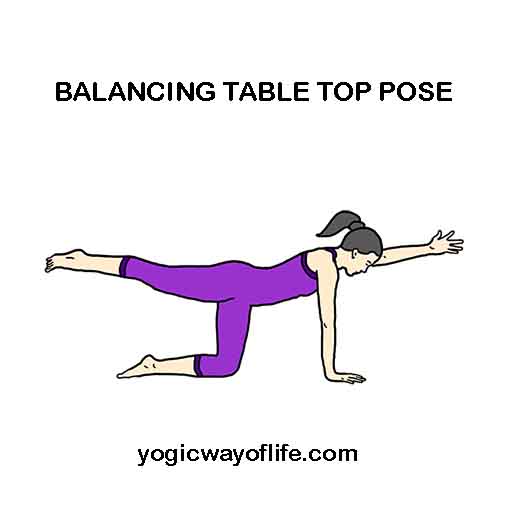Balancing Table Top Pose brings a sense of balance and strengthens the core muscles, hips, muscles of the lower back and the spine. This is a beginner’s pose and can be done by everyone.
How to do Balancing Table Top Pose?
- Start by sitting in the kneeling position or Vajrasana.
- Now assume the Table Top Pose as follows. Place both your hands in front with palms on floor facing forward. Raise yourself up and support yourself on the palms and the knees. Adjust and bring the palms under your shoulders. Take the tail bone backwards and stretch your neck forwards to make the spine straight. This is the simple Table Top Pose.
- Inhale and slowly raise the right leg up backwards making it parallel to the ground. Breathe normally now.
- Keep the gaze focussed between the palms. Again inhale and raise the left arm and make it parallel to the ground.
- Spread out the fingers of the left palm and let it point towards the front wall.
- Breathe normally and maintain this position for as long as you are comfortable.
- To release the pose, bring back the arms to the ground and simultaneously, bring back the right leg to the floor and come back to the simple Table Top Pose.
- Repeat the pose with the left leg raised backwards and the right arm raised in front.
Benefits of Balancing Table Top Pose
- Balancing Table Top Pose will improve the sense of balance.
- It strengthens the abdominal and lower back muscles.
- It strengthens the core muscles.
- This asana helps to elongate the spine and correct some postural defects.
- It can relive stress and tension, especially when awareness of breath is maintained.
Contraindications for Balancing Table Top Pose
- Those suffering from injury of knees or wrist should avoid this pose.
- If you have pain in the knees while doing this pose, you can use a soft folded blanket under the knees as support.
- Those who have undergone any recent surgery of the shoulders, arms, hips, abdomen, back, etc. should attempt this pose only after total recovery.

